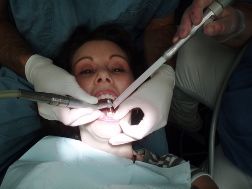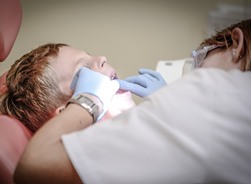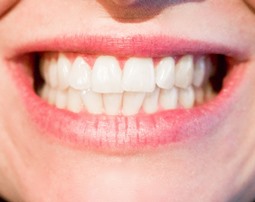How to Pick a Dental Hygienist School near Kensington Maryland
 Picking the right dental hygienist college near Kensington MD is an essential initial step toward starting your new career in dentistry. But before you can make your choice, you must examine and compare your school options. There is much more to performing your due diligence than choosing the school with the most affordable tuition or enrolling in the school that is closest to your residence. There are other significant factors to take into account as well, for instance the college’s reputation and accreditation. Dental hygienists usually earn an Associate Degree, as compared to a certificate usually earned by assistants, and can take anywhere from two to three years to complete. Naturally with the prolonged training of a hygienist comes more expense. We will discuss all of these issues and additional questions that you should be asking the dental hygienist programs you are reviewing later in this article. But first, let’s look at the duties of dental hygienists and the training programs offered.
Picking the right dental hygienist college near Kensington MD is an essential initial step toward starting your new career in dentistry. But before you can make your choice, you must examine and compare your school options. There is much more to performing your due diligence than choosing the school with the most affordable tuition or enrolling in the school that is closest to your residence. There are other significant factors to take into account as well, for instance the college’s reputation and accreditation. Dental hygienists usually earn an Associate Degree, as compared to a certificate usually earned by assistants, and can take anywhere from two to three years to complete. Naturally with the prolonged training of a hygienist comes more expense. We will discuss all of these issues and additional questions that you should be asking the dental hygienist programs you are reviewing later in this article. But first, let’s look at the duties of dental hygienists and the training programs offered.
[campusexplorer header_text=”Find Dental Hygienist Schools Near You!” aos=”75346615″ concentration=”2D77CE61″ tracking=”DENTHYG”]
The Job of Dental Hygienists
 When comparing the role of a dental assistant to that of a hygienist, the most significant difference is probably that the hygienist works more on their own. Dental assistants work with and assists the Kensington MD dentists and the practice. Hygienists, while also supporting the practice, work with the patients more on an individual basis. They are usually the first person a patient sees when called from the waiting area. They examine each patient’s teeth and gums and present their results to the dentists. They may also carry out basic procedures. Based on state law, a hygienist’s responsibilities can include:
When comparing the role of a dental assistant to that of a hygienist, the most significant difference is probably that the hygienist works more on their own. Dental assistants work with and assists the Kensington MD dentists and the practice. Hygienists, while also supporting the practice, work with the patients more on an individual basis. They are usually the first person a patient sees when called from the waiting area. They examine each patient’s teeth and gums and present their results to the dentists. They may also carry out basic procedures. Based on state law, a hygienist’s responsibilities can include:
- Removing tartar, stains and plaque
- Administering fluoride treatments
- Polishing teeth and applying sealants
- Teaching patients regarding oral care
- Taking X-rays and developing film
- Removing sutures and applying fillings
To qualify for licensing in nearly all states, dental hygienists must have graduated from a Commission on Dental Accreditation (CDA) accredited dental hygiene program. They also must pass the National Board Dental Hygiene Examination as well as any state licensure examinations. After they have completed these requirements they are considered fully licensed and may add the “RDH” designation to their names, signifying Registered Dental Hygienist.
Dental Hygienist Training Options
As a result of the added responsibility in contrast to an assistant, dental hygienists working in Kensington MD dental practices are generally required to have an Associate Degree in dental hygiene rather than a certificate. These programs can take anywhere from 2 to as long as 3 years to finish and must be accredited by the CDA in virtually every state. They are offered in trade and vocational schools as well as community colleges. And in addition to classroom studies learning the fundamentals of dental hygiene, there will be a practical component to the training as well| A number of programs also offer internships with local dental practices or dentists.
Dental Hygienist Online Schools
 Enrolling in an online dental hygienist school might be a good option for receiving your education. Just keep in mind that the program will not be totally online, since there will be a practical component to your training. But the balance of your classes will be accessible via your desktop computer in the convenience of your Kensington MD home or anywhere else on your tablet or laptop. For those working while attending school, online dental programs make education much more accessible. Some may even offer lower tuition fees than their on-campus counterparts. And supplementary expenses for items like books, school supplies and commuting may be reduced also. The practical training can usually be completed at a community dental office or in an on-campus lab. With both the online and clinical training, everything required to obtain the proper education is provided. If you have the discipline for this method of learning, you may find that enrolling in an online dental hygienist program is the right option for you.
Enrolling in an online dental hygienist school might be a good option for receiving your education. Just keep in mind that the program will not be totally online, since there will be a practical component to your training. But the balance of your classes will be accessible via your desktop computer in the convenience of your Kensington MD home or anywhere else on your tablet or laptop. For those working while attending school, online dental programs make education much more accessible. Some may even offer lower tuition fees than their on-campus counterparts. And supplementary expenses for items like books, school supplies and commuting may be reduced also. The practical training can usually be completed at a community dental office or in an on-campus lab. With both the online and clinical training, everything required to obtain the proper education is provided. If you have the discipline for this method of learning, you may find that enrolling in an online dental hygienist program is the right option for you.
What to Cover With Dental Hygienist Colleges
 Now that you have decided to become a dental hygienist in Kensington MD, you can begin the procedure of comparing schools and programs. As we covered at the opening of this article, a number of students start by checking out the cost and the location of the colleges. Possibly they search for some online alternatives as well. Even though these are relevant initial factors to consider, there are several additional questions that you should address to the schools you are comparing in order to arrive at an informed decision. Toward that end, we have included a list of questions to help you with your evaluation and final selection of the right dental hygienist college for you.
Now that you have decided to become a dental hygienist in Kensington MD, you can begin the procedure of comparing schools and programs. As we covered at the opening of this article, a number of students start by checking out the cost and the location of the colleges. Possibly they search for some online alternatives as well. Even though these are relevant initial factors to consider, there are several additional questions that you should address to the schools you are comparing in order to arrive at an informed decision. Toward that end, we have included a list of questions to help you with your evaluation and final selection of the right dental hygienist college for you.
Is the Dental Program Accredited? There are a number of important reasons why you should only choose an accredited dental hygienist college. If you are going to become certified or licensed, then accreditation is a prerequisite in nearly all states. In order to take the National Board Dental Hygiene Exam, your dental school must be accredited by the Commission on Dental Accreditation (CDA). Accreditation also helps guarantee that the training you receive is comprehensive and of the highest quality. Kensington MD employers frequently prefer or require that job applicants are graduates of accredited schools. And finally, if you are requesting a student loan or financial aid, usually they are not provided for non-accredited programs.
Is Adequate Practical Training Included? Clinical or practical training is a vital part of any dental training program. This applies for the online school options as well. Many dental hygienist colleges have partnerships with local dental offices and clinics that provide clinical training for their students. It’s not only essential that the college you choose provides sufficient clinical hours but also provides them in the type of practice that you subsequently want to work in. For example, if you have an interest in a career in pediatric dentistry, confirm that the program you select offers clinical rotation in a local Kensington MD dental office that focuses on dental treatment for children.
Are Internships Available? Ask if the dental schools you are looking at have an internship program. Internships are probably the ideal way to receive hands-on, clinical experience in a professional dental practice. They help students to transition from the theoretical to the practical. They can also help students create professional relationships in the Kensington MD dentistry community. And they look good on resumes also.
Is Job Placement Support Furnished? Many graduating students of dental hygienist colleges require help obtaining their first job. Find out if the colleges you are researching have job assistance programs, and what their job placement rates are. Programs with high job placement rates probably have excellent reputations within the Kensington MD dental community as well as extensive networks of contacts where they can place their students for employment or internships.
Are the Classrooms Smaller? Ask the programs you are interested in how big typically their classrooms are. The smaller classes tend to provide a more intimate environment for training where students have greater access to the teachers. On the other hand, large classes often are impersonal and provide little one-on-one instruction. If practical, ask if you can attend a few classes at the Kensington MD dental hygienist school that you are leaning toward so that you can experience first hand the level of interaction between students and teachers before making a commitment.
What is the Entire Cost of the Program? Dental hygiene training can vary in cost dependent on the length of the program and the amount of practical training provided. Other variables, for example the reputations of the schools and whether they are public or private also have an impact. But along with the tuition there are other significant expenses which can add up. They can include expenses for such things as textbooks and commuting as well as school equipment, materials and supplies. So when examining the cost of colleges, remember to add all of the costs associated with your education. The majority of schools have financial aid offices, so make sure to check out what is offered as far as loans, grants and scholarships in the Kensington MD area.
Are the Classes Convenient? Before enrolling in a dental hygienist school, you need to verify that the hygienist or assistant program offers classes that accommodate your schedule. This is particularly true if you continue working while receiving your education and have to go to classes near Kensington MD at nights or on weekends. And even if you enroll in an online program, you will still be required to schedule your clinical training classes. Also, while addressing your concerns, ask what the make-up practice is if you should need to miss any classes because of illness, work or family responsibilities.
Attending Dental Hygienist School near Kensington MD?
Kensington, Maryland
The area around the Rock Creek basin where Kensington is located was primarily agricultural until 1873, when the B&O Railroad completed the Metropolitan Branch which traversed Montgomery County. A community arose where the new railroad line intersected the old Rockville-to-Bladensburg road. This early settlement was first known as Knowles Station. In the early 1890s, Washington, D.C. developer Brainard Warner began purchasing land parcels to build a planned Victorian community, complete with church, library and a local newspaper. Fascinated by a recent trip to London, Warner named his subdivision Kensington Park, the 10th and largest subdivision in the area which became the Town of Kensington. Upon incorporation in 1894, Warner convinced the Mayor and Council to name the town Kensington.[5] The historic core of Kensington was listed on the National Register of Historic Places, as the Kensington Historic District in 1980.[6]
Originally a farming community at Knowles Station, Kensington developed into a summer refuge for Washington, D.C., residents wishing to escape the capital's humid summers. As years passed and its residents increasingly remained year round, Kensington evolved into a commuter suburb. The large southernmost section originally mapped out by Warner remains largely unchanged since inception, and is a historically preserved zone. Indeed, the only major changes in the town's basic layout have been the bridging over of the original railroad crossing in 1937, and the extension and widening of Connecticut Avenue, the town's main thoroughfare, in 1957.
In March 1975, Kensington gained attention regionally due to the disappearance of Sheila and Katherine Lyon. The sisters walked to Wheaton Plaza, a local shopping mall where they were seen by witnesses including their brother. However, they never returned home and the case remains unsolved.
The town gained national attention three times in a 10-month span early in the 21st century as a result of events which occurred within a mere quarter-mile radius. In December 2001, the town responded to complaints from anonymous citizens by banning Santa Claus from the annual holiday parade. Protesters arrived at the parade en masse, including dozens of Santas riding everything from motorcycles to fire trucks. Eight months later, an Amtrak train derailed adjacent to the town center when the tracks separated at an overheated joint, injuring 72 people,[7] though there were no fatalities. Then, on October 2, 2002, Lori Ann Lewis-Rivera became the fifth victim of the snipers who terrorized the Washington area that month, while cleaning her auto at a Kensington gas station. (See Beltway sniper attacks.)
Pick the Best Dental Hygienist College near Kensington MD
Enrolling in the ideal dental hygienist program is imperative if you want to take the National Board Dental Hygiene examination or, if required in your state, become licensed. As we have covered, there are several options offered to obtain your training and it takes a fairly short amount of time to become a dental hygienist. You can receive your formal training through dental programs at junior colleges, technical institutes, trade schools and vocational schools. Graduates of these programs normally obtain an Associate Degree. Dental Hygienists generally require roughly two years of studies before they enter the job market. When obtaining a degree you can choose to attend classes online or on-campus. Whichever mode of training you decide to pursue, by asking the questions presented in this article you will be better prepared to make the best choice. And as a result, you will be ready to commence your journey toward becoming a dental hygienist in Kensington MD.
More Great Cities in Maryland
Business Results 1 - 10 of 981













